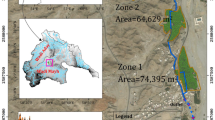Abstract
The objective of the present paper is to propose a framework for development of an optimal cropping pattern aimed at ground water recovery using an agent based approach. In the proposed agent-based model (ABM), the agents’ learning from each other as well as their self-learning from their own behavioral feedback was studied through simulation of the behavior of agricultural agents using fuzzy inference system (FIS). Moreover, the agents’ behavior were determined using linear programming in order to maximize the farmers’ income. The governmental agent regulated the interactions between agricultural and environmental agents by imposing its policies in the form of scenarios. The efficiency of the presented methodology was evaluated using hydrological data of Najaf Abad region, located in Iran’s central plain, on the basis of three hydrological scenarios (wet, normal, and dry) subject to governmental policy of aquifer recovery. The results showed that in a normal scenario with current groundwater withdrawal, the water level reduced by an average of 0.18 m per year. In contrast, the water level increased by an average of 0.48 m under aquifer recovery scenario. Furthermore, despite 17% reduction in water rights of agricultural agents in the study area, the total long-term agricultural income declined only by less than 4%, and in the planning horizon, their average annual income associated with these two management scenarios were estimated at 123.5 and 119 million US dollars, respectively.





Similar content being viewed by others
References
Akhbari M, Grigg NS (2013) A framework for an agent-based model to manage water resources conflicts. Water Resour Manag 27(11):4039–4052
Aljanabi A, Mays L, Fox P (2018) Optimization Model for Agricultural Reclaimed Water Allocation Using Mixed-Integer Nonlinear Programming. Water 10(10):1291
Bear J (1979) Hydraulics of groundwater McGraw-Hill. Inc, New York
Berglund EZ (2015) Using agent-based modeling for water resources planning and management. J Water Resour Plan Manag 141(11):04015025
Darbandsari P, Kerachian R, Malakpour-Estalaki S (2017) An Agent-based behavioral simulation model for residential water demand management: The case-study of Tehran, Iran. Simul Model Pract Theory 78:51–72
Das B, Singh A, Panda SN, Yasuda H (2015) Optimal land and water resources allocation policies for sustainable irrigated agriculture. Land Use Policy 42:527–537
Farhadi S, Nikoo MR, Rakhshandehroo GR, Akhbari M, Alizadeh MR (2016) An agent-based-nash modeling framework for sustainable groundwater management: A case study. Agric Water Manag 177:348–358
Galán J M, López-Paredes A, Del Olmo R (2009) An agent-based model for domestic water management in Valladolid metropolitan area. Water resources research 45(5)
Giacomoni M H, Zechman E M (2010) A complex adaptive systems approach to simulate urban water resources sustainability. In Proceedings of the World Environmental and Water Resources Congress 2010, Providence, Rhode Island, USA, 16–20 May, 2010 (pp 2543–2549). American Society of Civil Engineers (ASCE)
Gunkel A (2005) The application of multi-agent systems for water resources research–Possibilities and limits (Doctoral dissertation, Ph. D. thesis, Institut für Hydrologie der Albert-Ludwigs-Universität Freiburg, Freiburg)
Heydari F, Saghafian B, Delavar M (2016) Coupled quantity-quality simulation-optimization model for conjunctive surface-groundwater use. Water Resour Manag 30(12):4381–4397
Kanta L, Zechman E (2013) Complex adaptive systems framework to assess supply-side and demand-side management for urban water resources. J Water Resour Plan Manag 140(1):75–85
Khare D, Jat MK, Sunder JD (2007) Assessment of water resources allocation options: conjunctive use planning in a link canal command. Resour Conserv Recycl 51(2):487–506
Kim D, Kaluarachchi JJ (2016) A risk-based hydro-economic analysis for land and water management in water deficit and salinity affected farming regions. Agric Water Manag 166:111–122
Koutiva I, Makropoulos C (2016) Modelling domestic water demand: An agent based approach. Environ Model Softw 79:35–54
Levin S, Xepapadeas T, Crépin AS, Norberg J, De Zeeuw A, Folke C, Ehrlich P (2013) Social-ecological systems as complex adaptive systems: modeling and policy implications. Environ Dev Econ 18(2):111–132
McDonald M G, Harbaugh A W (1988) A modular three-dimensional finite-difference ground-water flow model (Vol. 6, p. A1). Reston, VA: US Geological Survey
Murray-Rust D, Robinson DT, Guillem E, Karali E, Rounsevell M (2014) An open framework for agent based modelling of agricultural land use change. Environ Model Softw 61:19–38
Ng TL, Eheart JW, Cai X, Braden JB (2011) An agent-based model of farmer decision-making and water quality impacts at the watershed scale under markets for carbon allowances and a second-generation biofuel crop. Water Resources Research 47(9)
Ni J, Liu M, Ren L, Yang SX (2013) A multiagent Q-learning-based optimal allocation approach for urban water resource management system. IEEE Trans Autom Sci Eng 11(1):204–214
Nikolic VV, Simonovic SP, Milicevic DB (2013) Analytical support for integrated water resources management: a new method for addressing spatial and temporal variability. Water Resour Manag 27(2):401–417
Peralta RC, Forghani A, Fayad H (2014) Multiobjective genetic algorithm conjunctive use optimization for production, cost, and energy with dynamic return flow. J Hydrol 511:776–785
Plummer PS, Sheppard E, Haining RP (1998) Modeling spatial price competition: Marxian versus neoclassical approaches. Ann Assoc Am Geogr 88(4):575–594
Perera EDP, Lahat L (2015) Fuzzy logic based flood forecasting model for the Kelantan River basin, Malaysia. J Hydro Environ Res 9(4):542–553
Singh A (2014) Simulation–optimization modeling for conjunctive water use management. Agric Water Manag 141:23–29
Voinov A, Bousquet F (2010) Modelling with stakeholders. Environ Model Softw 25(11):1268–1281
Author information
Authors and Affiliations
Corresponding author
Additional information
Publisher’s Note
Springer Nature remains neutral with regard to jurisdictional claims in published maps and institutional affiliations.
Rights and permissions
About this article
Cite this article
Nouri, A., Saghafian, B., Delavar, M. et al. Agent-Based Modeling for Evaluation of Crop Pattern and Water Management Policies. Water Resour Manage 33, 3707–3720 (2019). https://doi.org/10.1007/s11269-019-02327-3
Received:
Accepted:
Published:
Issue Date:
DOI: https://doi.org/10.1007/s11269-019-02327-3




